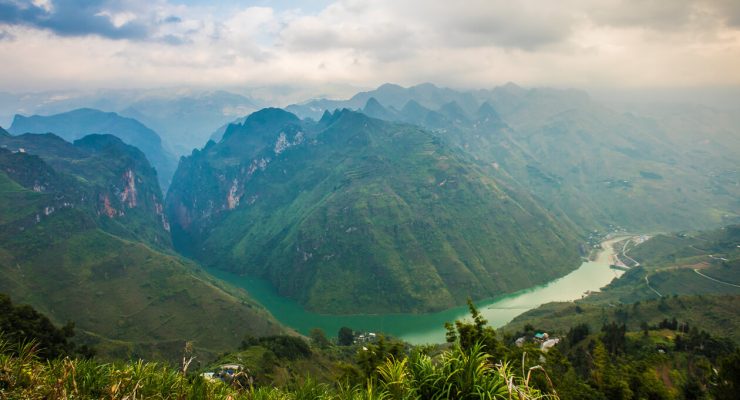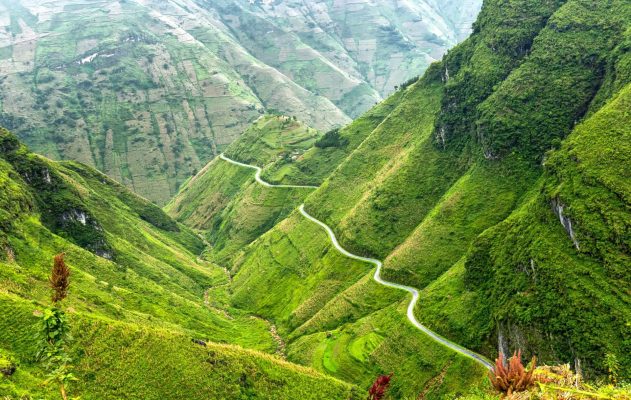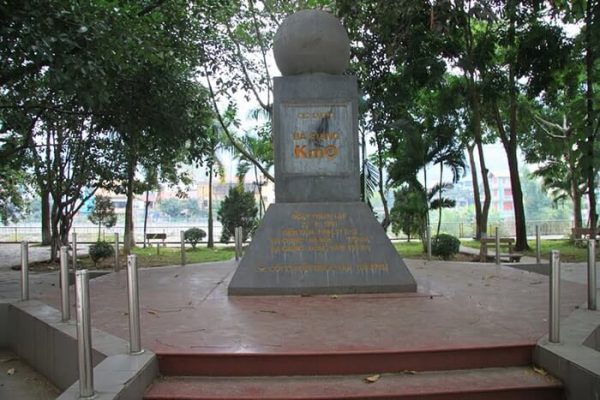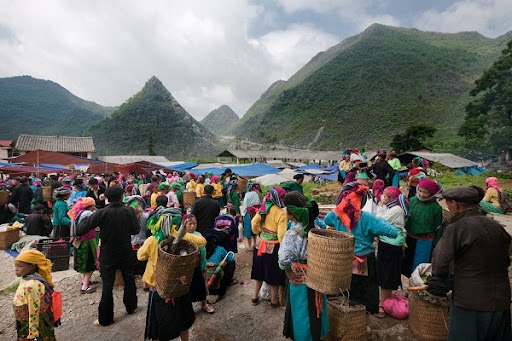As the top land of the country with the Dong Van Rocky Plateau and the Hoang Su Phi Terraced Landscape, Ha Giang has long been a very popular land in the community of friends who love to move. In recent years, due to the development of transport infrastructure as well as services and facilities invested, Ha Giang tourism is more and more popular. Ha Giang tours are continuously open, and homestay services in Ha Giang flourish. Ha Giang is more crowded, often congested on peak occasions, and many new tourist sites have been built to serve tourists. In order to have a fun and safe Ha Giang trip, do not miss the detailed instructions below.
Table of Contents
General Information about Ha Giang
Ha Giang is a province in the northeastern region of Vietnam. The East borders Cao Bang province, the West borders Yen Bai and Lao Cai provinces, the South borders Tuyen Quang province, and the North borders China. Ha Giang has a natural area of 7,884.37 km2, of which the widest place from West to East is 115km long and 137km from North to South. Ha Giang’s north pole is also the northernmost point of the country, about 3km east of Lung Cu, with latitude 23º13’00 ”.
At the time of Hung Vuong, Ha Giang was one of 15 ministries of Lac Viet country. Under Thuc Phan, An Duong Vuong founded Au Lac, Ha Giang, belonging to the Tay Vu tribe. During the thousand-year colonial period of Northern feudalism, the Ha Giang area was still in the territory of Tay Vu district in Giao Chi district. From 1075 (Ly dynasty), Ha Giang at that time belonged to Binh Nguyen. At the beginning of the Tran dynasty, the area of Ha Giang and Tuyen Quang at that time was called Chau Tuyen Quang on Quoc Oai highway. In 1397 it was changed to Tuyen Quang town. In 1858, after conquering most of the provinces of Cochinchina and Tonkin, in 1887, the French colonialists invaded Ha Giang and changed the regime by setting up army officers. On March 23, 1959, President Ho Chi Minh signed a decree to dissolve the Lao-Ha-Yen Area, merging Ha Giang province into the Viet Bac Autonomous Region. In early April 1976, Ha Tuyen province was established based on the merger of the two provinces of Ha Giang and Tuyen Quang. On August 12, 1991, the National Assembly decided to divide Ha Tuyen province into two provinces, Ha Giang and Tuyen Quang. Ha Giang Province was re-established as the provincial capital located in Ha Giang town (now Ha Giang city).
Located in a mountainous area in the northern part of Vietnam, Ha Giang is a complex of majestic mountains, rugged terrain, with an average altitude of 800 meters to 1,200 meters above sea level. This is an area with many high mountains. According to recent statistics, on a strip of land less than 8,000 km2 in Ha Giang, there are 49 mountains high from 500m – 2,500 m (10 peaks 500 – 1,000 m, 24 peaks 1000 – 1500m, 10 tops of 1,500-2,000 m and 5 tops from 2,000 – 2,500 m).
Ha Giang still has many untapped primeval forests, the ecological environment is fresh and contains many interesting potentials. The rocky forests, undulating and undulating hidden in silver clouds, many mountain peaks over 2,000 m high such as Pu Ta Kha, Tay Con Linh; many mysterious caves such as Tung Ba, Lung Ma, (Vi Xuyen), Tung Vai (Quan Ba), Hang May, Sang Tung (Dong Van).
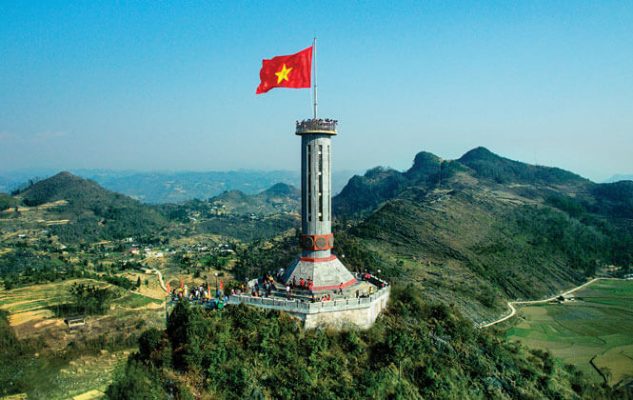
Ha Giang is endowed with a long-standing culture of Dong Son bronze age, with prehistoric relics in Bac Me and Meo Vac. This is also a province with many ethnic minorities living in the Northeast, with 22 ethnic groups with many customs, traditional cultures, and lively festivals making Ha Giang become an attractive place for tourists. come to visit. Besides, Ha Giang has a unique environmental landscape of a mountainous province with rocky mountains in the north and immense forests in the south. In 2010, Dong Van Plateau Geopark (Geopark) was recognized by UNESCO as a member of the global Geopark network. September 2012 Hoang Su Phi Terraced Field was recognized as a National Monument.
When Should visit Ha Giang?
If you have not been to Ha Giang before, you can arrange travel to Ha Giang according to the time you have free time because Ha Giang is a destination that according to tourists, “every season is beautiful”.
- October-November is the Triangular Circuit flower season, you go around the 3rd week of October until around the beginning of November is beautiful.
- From about December to the Lunar New Year, there will usually be yellow mustard flowers scattered in some places such as Quyet Tien, Pho Fox, and Sung La.
- Before and after the Lunar New Year is the time of plum blossoms and cherry blossoms respectively.
- Around June-August is summer, Ha Giang it’s always sunny, which is a good time to take beautiful pictures of rocky plateaus, but it often rains in summer.
- September is the ripe rice season of the highlands, so visiting Hoang Su Phi is great.
Guide to Ha Giang
By Public transport
By Planes
The plane is the means for you to live far away (usually the Central and the South) if you want to go to Ha Giang. This upland province still does not have an airport, so you need to take the flight to Hanoi first and then move to Ha Giang.
Find ways to get Ha Giang easier with Bookaway!
By Bus
The bus trips to Ha Giang will usually go in the direction of Highway 2, quite close to Noi Bai airport, so if you land in the late evening, you can move to Noi Bai – Phuc Yen intersection and wait for the car to go always.
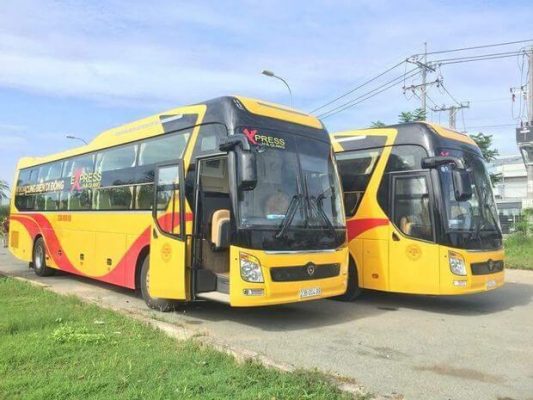
By Passenger cars
With a distance of about 320km, the travel time from Hanoi to Ha Giang is about 8 hours. The bus routes usually depart from My Dinh bus station in the evening and will be available in Ha Giang city early in the morning.
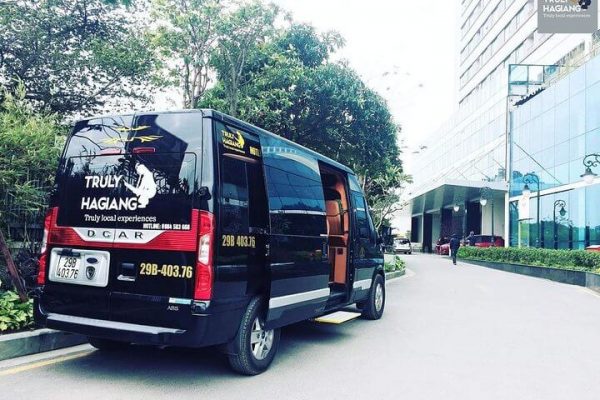
By Private vehicles
From Hanoi to Ha Giang is about 300km, if you like autonomy in your travel or change the way back to another route, you can completely ride your motorbike or personal car from Hanoi. Time to Hanoi – Ha Giang will be about 8-10 hours depending on speed, plus rest time.
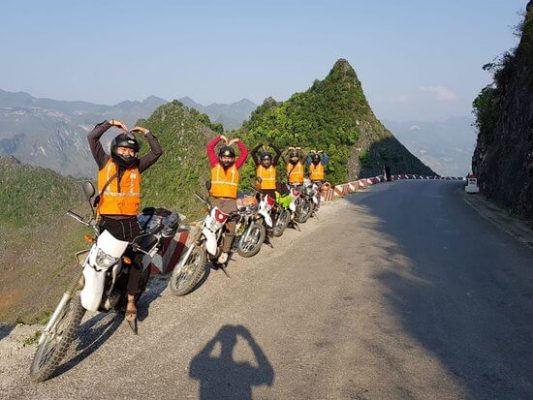
If you want to bring a motorbike but do not want to run from Hanoi, you can send your motorbike by bus to Ha Giang. The downside of this plan is that you need to book early with the garage because each bed car can only bring 2-3 motorbikes and not always they accept to carry the car.
Traveling in Ha Giang
By Motorcycle
Conquering and exploring Ha Giang is nothing more wonderful than riding a motorbike. If you want to bring your motorbike to use, you can attach your motorbike with your car, but if you want a simple and lightweight trip, you can choose to go and rent a motorbike to discover Ha Giang.
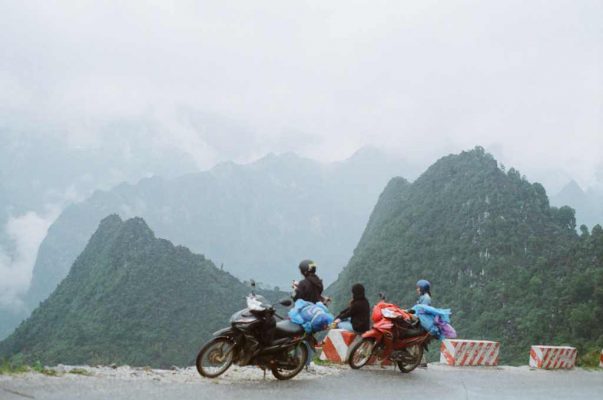
By Coach
From Hanoi, after riding a Sleeper bus to Ha Giang, you continue to use the bus routes to the highland districts of Quan Ba, Yen Minh, Dong Van, and Meo Vac. To the center of the district, you can continue to rent a motorbike taxi to go to the attractions. This method may only suit 1-2 people (especially girls) and cannot ride a motorbike in highland areas.
Rent a car
In the past, traveling in Ha Giang did not have many choices. Most people often go in groups from Hanoi by motorbike or car, going straight to Ha Giang to favorite places. However, since a few years ago, Ha Giang has become one of the most attractive tourist destinations in the North, so Ha Giang tourism services have appeared. You can rent a 7-seater car with a driver in Ha Giang to take it away for about 2 days with a price of about 4,000,000 VND.
Staying in Ha Giang
Although it is a destination that many tourists choose on every holiday, the hotel and motel service in Ha Giang is not much and varied, the shortage of rooms and price increases on holidays is often encountered. To avoid this, you should have a reservation plan for your group before you go, refer to the list of hotels and motels in Ha Giang.
Usually, 99% of you when traveling to Ha Giang sleep at least one night in Dong Van, also because this is a land with many interesting places and activities. This is also the most suitable place to rest after a day exploring rocky plateaus, north pole, or triangular fields.
However, in some cases (especially during peak occasions) the hotel room in Dong Van is no longer available, you can move to nearby locations with Dong Van to sleep like Pho Bang or right in the Lung Cu Commune. A little further away, Meo Vac also has many motels, homestay,s or hotels that can provide accommodation for you.
Hotel
Previously, Ha Giang City and the districts mostly only existed small hotels (slightly better quality than motels), but with the expansion of Ha Giang tours, the demand for services of tourists is also higher, so many good quality hotels in Ha Giang have been newly built. Although not comparable to big cities, these hotels are generally quite nice, offering a full range of services to guests.
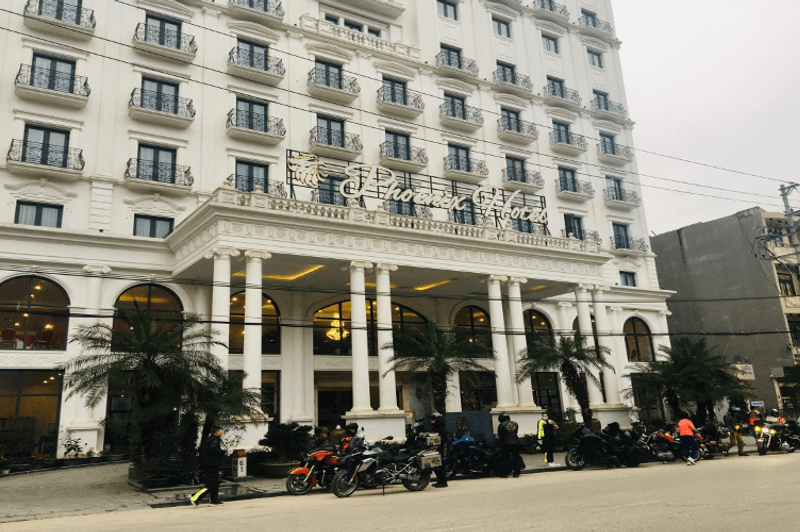
Hostel
Guesthouses, one of the most popular accommodation types in Ha Giang. Due to the low cost and large quantity, motels often attract groups of young people who go backpacking and backpacking in Ha Giang. The motels also have all that the hotel has to offer but the quality will be a bit lower, that’s the basic difference. In addition, with motels you can easily negotiate to stay in more people than prescribed (usually 2 people 1 room) with a reasonable extra cost, hotels will make this tighter.
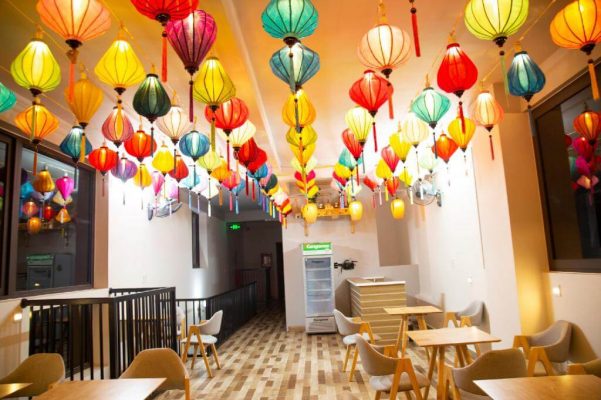
Homestay
A homestay is a form of community travel, for travelers who want to explore, experience, and learn about the customs of local people. Here you can eat, rest, and participate in family activities to feel more about daily life and the cultural characteristics of each indigenous ethnic group. Currently, most tourist districts of Ha Giang develop homestay services, the most popular being homestay services in Dong Van, homestay in Quan Ba, homestay in Xin Man, homestay in Hoang Su Phi.
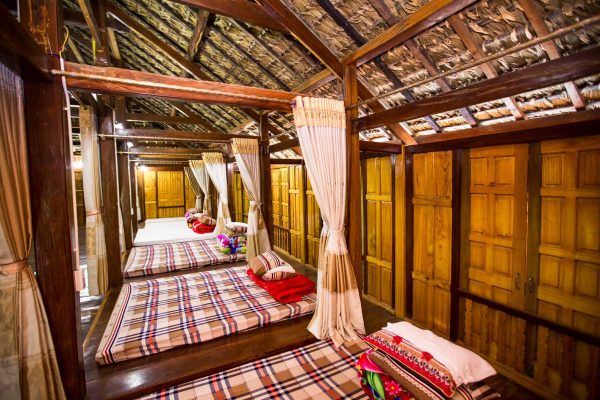
Sleep tent
If you like a little dust, a little wild, you can bring a tent to sleep in overnight. However, you should choose low places to set up a sleeping tent that will be warmer. If you stand at a high altitude, you should bring a warm sleeping bag.
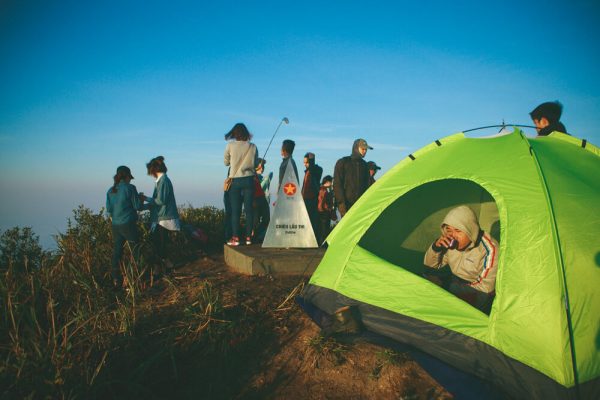
Tourist attractions in Ha Giang
If you ask what the typical destinations of Ha Giang are, you will be able to answer immediately: Lung Cu flagpole, Quan Ba heaven gate, or Dong Van rocky plateau,… Let’s point out a few attractive places to suit your short trip.
What to play in Ha Giang
Take photos of flowers
Not only has the typical beauty of the rocky plateau, but Ha Giang also has many attractive flowers, depending entirely on when you come to Ha Giang.
Peach Blossom & Plum Blossoms
Every late winter, starting to spring when the cold has subsided and the weather warms up is the season of these two flowers. Coming to Ha Giang at this time is very popular because there are not many visitors like the triangle circuit season.
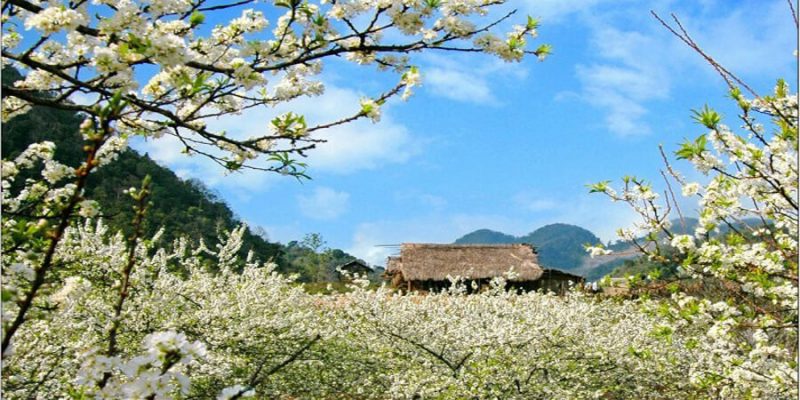
Triangle Circuit
From an inherent flower, the triangular circuit has become a symbol of Ha Giang tourism. Come to Ha Giang, if at the right time of October to November, you definitely cannot miss the opportunity to have beautiful pictures with this flower.
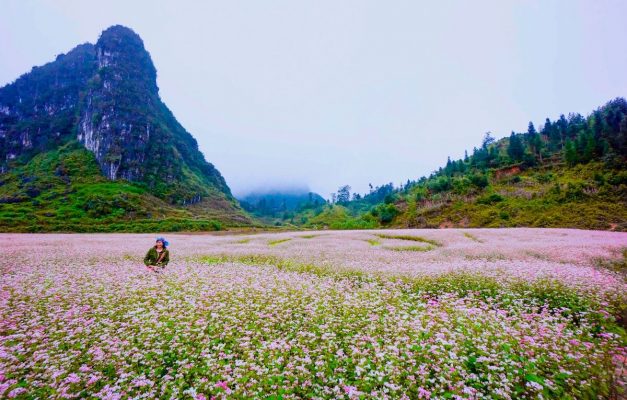
Currently, in Ha Giang, many triangles are planted to serve tourists. However, to have beautiful pictures, you should stop at some places such as Thach Son Than (Quan Ba), Sung La and Lung Tao (Dong Van), or the Pa Vi (Meo Vac) field.
Go to the fair
The upland fair is always an indispensable cultural activity of the local people. In addition to the purpose of exchanging goods, a fair is also an exchange place for the people here. Although nowadays, the markets in Ha Giang are somewhat more modern with a full range of items, from agricultural products to electronic appliances, many cultural features are still preserved. If you have never experienced it, you should buy yourself a Mongolian scarf, wrap it on your head and do a few rounds around the market.
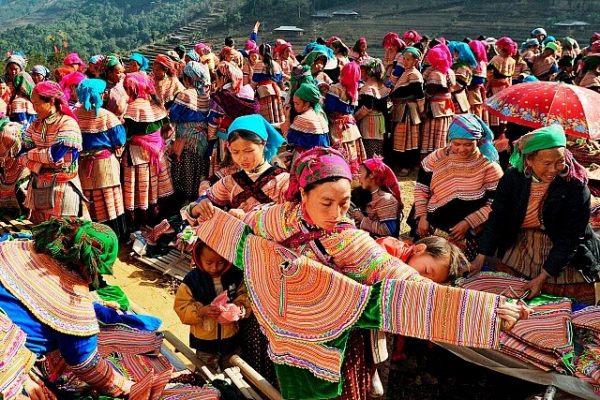
Boat ride on Nho Que River
Nho Que River originates in China, flows into Vietnam in the northernmost region of Lung Cu. After passing Tu San gorge, running along Ma Pi Leng Pass to Meo Vac, Nho Que river separates and flows into Cao Bang province and finally pouring water into Gam river. For a few years, the boat cruise on the Nho Que River has developed to serve the needs of visitors who want to see the Tu San alley right under the river. You can choose to take a boat at Ta Lang wharf (downstream) or a boat station in the area of Xin Cai commune (upstream).

Driving on Ma Pi Leng
Ma Pi Leng, one of the four great mountain passes in the North, is one of the places that most of you passionate about travel want to conquer at least once. This Pass is about 20km long with extremely majestic scenery. If you can drive, you should not miss this experience.
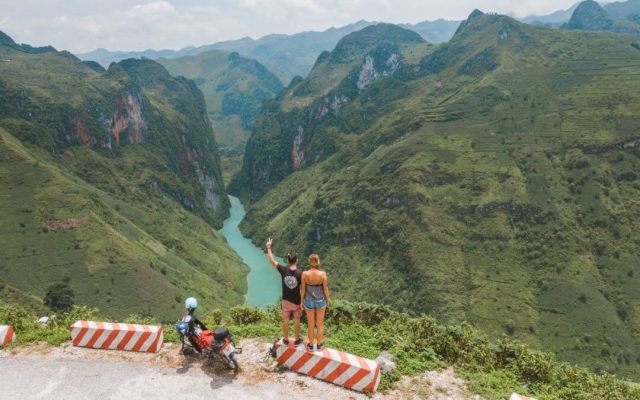
Explore border landmarks
Ha Giang is one of the northern provinces having a border with China, border markers in Ha Giang start from milestone 172 to milestone 517. Many landmarks are quite easy to conquer because they are located close to the border roads. But there are also landmarks where you have to hike for hours with a guide to get there.
Ha Giang City
Milestone Km0
This is a milestone marking the starting point of the Hanh Phuc road connecting Ha Giang City and 4 districts in the rocky plateau. This is also the starting point for the journey to discover Ha Giang that most visitors will encounter here.
Quan Ba
Quyet Tien Market
Quyet Tien commune is peaceful once a week with a fair, a period daily that takes place only in a short morning. Quyet Tien Market meets every Saturday morning, right next to National Highway 4C, about ten kilometers from Quan Ba Sky Gate.
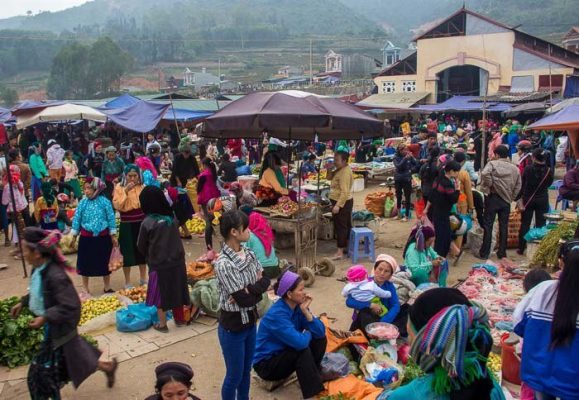
Perhaps many of you will comment that the Ha Giang fair is the same everywhere, looks the same, still has colorful clothes, selling everyday items, usually only meeting in the morning,… If so then Quyet Tien can be considered as the first upland market that you meet on the way to conquer Ha Giang. Do not miss, after departing from Ha Giang City for just over an hour, you will come to Quyet Tien, send your car and do a round of the market, eat a package of five-color sticky rice or any other dish and then carry your camera around the market. You will find out what is unique about this market.
Quan Ba Heaven’s Gate
Quan Ba Sky Gate – 1500m above sea level, this is the first gateway to Dong Van Plateau. In 1939, people built a giant wooden door 150cm thick at the Gate of Heaven. At one time, behind this wooden door was another “world” – also known as “The autonomous region of the Meo people”, comprising the districts of Quan Ba, Meo Vac, Yen Minh, and Dong Van.
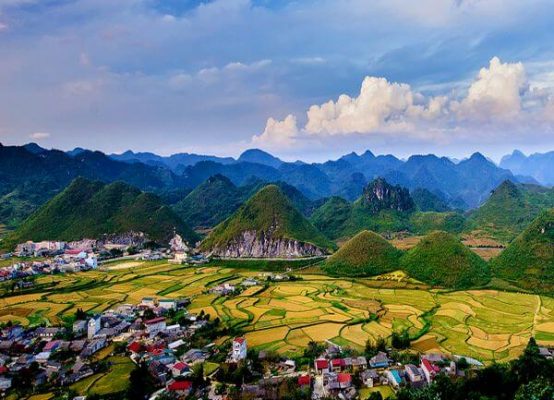
Ba Quan Twin Mountain
Quan Ba Double Mountain, located next to National Highway 4C, 40 km from Ha Giang City. Between the rocky mountains and terraced fields, two strange-shaped mountains emerge, making visitors amazed by the great beauty of nature. These two mountains are associated with the legend of Mount Co Tien poetically.
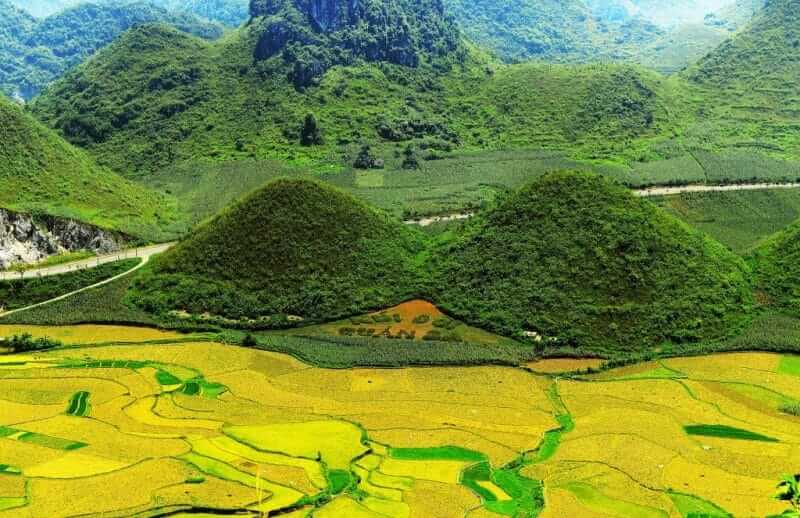
Lung Khuy Cave
About 3km from Tam Son Town, the center of Quan Ba district, Lung Khuy Cave has the same name as the beautiful Lung Khui village of the Mong people living at the foot of the mountain. Before being put into exploitation for tourism, Lung Khuy Cave is a place closely linked with the spiritual life of the Mong ethnic people in Lung Quy Village.
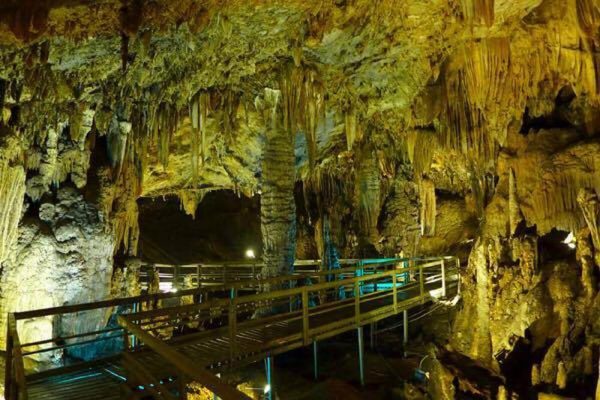
Lonely tree
This is a check-in spot that many young people love. This lonely tree location is located in Can Ty commune, on the way from Quan Ba to Yen Minh. You will notice that right at the Can Ty bridge, there will be 2 roads going to Yen Minh, the lower one is farther but a bigger and more beautiful road, going through the Yen Minh pine forest. The line above will be closer to this check-in point.
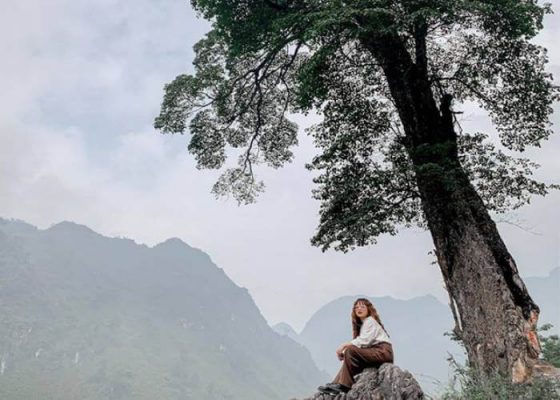
Yen Minh
Yen Minh Pine Forest
Yen Minh is about 100km northeast of Ha Giang city, along Highway 4C running from Can Ty to the district’s center through three communes: Bach Dich, Na Khe, Lao, And Chai have a dreamlike road that makes you feel as standing in the middle of Da Lat. The beautiful road of Yen Minh pine forest starts from Na Khe commune to Yen Minh town, the section of national highway 4C with both sides of the road.
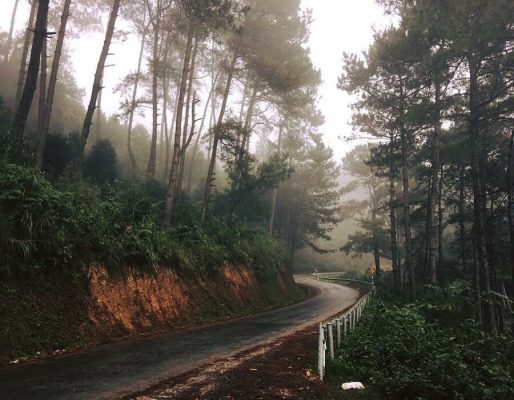
Bach Dich Market
Along with Highway 4C from Ha Giang City, after about 70km, to Na Khe commune and about 20km from Yen Minh town, turn left (with signposts) about 20km more to Bach Dich commune. Bach Dich is a border commune with 6 villages bordering China, the total length of the border is more than 7 km. The commune has a unique and unique character. There is no place here that has up to 3 markets a month, including Ban Muong market, Moc 358 market, and the commune center market. The markets are held in sessions on a daily basis on the Body and the Tiger Day each month.
Speaking of Moc market 358, also known as Moc 9 market, this is both a fair market and a border market; lying right at the foot of the landmark, taking a dozen more steps to reach Bach Dich Border Gate. The market is held by session, if it is not in the right session, the border gate is still operating normally, but the market is empty of buyers and sellers. Moc Market 358 was established in 2007, is a place to exchange, trade, and purchase goods between local people and people on the other side of the border. The market is held from about 6 am to 1 pm, the stalls are located along the two sides of the border, about 10m from the border.
Du Gia
This is a relatively attractive destination but not many people know it because the road is a bit difficult. In the past, when it rained, this route was almost a nightmare for those of you who love backpacking. Later, along with the development of tourism, the road to Du Gia was relatively easier to go, and most vehicles could move here.
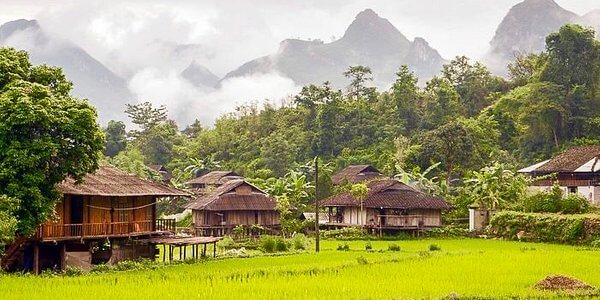
Du Gia with well-protected primeval forests is located in the population of Du Gia National Park – Dong Van Rock Plateau; There are thousands of species of flora and fauna, many of which are rare and preserved. This place also has terraced fields and majestic rocky mountains, geological formations typical of Dong Van’s rocky plateau.
Dong Van
Dong Van Plateau
Dong Van rocky plateau (or Dong Van plateau) is a rocky plateau spreading over four districts of Quan Ba, Yen Minh, Dong Van, and Meo Vac in Ha Giang province, Vietnam. On October 3, 2010, the record “Dong Van Plateau Geopark” was officially recognized as a Global Geopark by UNESCO’s Global Geopark Network Advisory Council (GGN). Before 2018, this was the only place in Vietnam to achieve this title. Then, in turn, Cao Bang Non-Nuoc Geopark was recognized in 2018, Dak Nong Geopark was recognized in 2020.
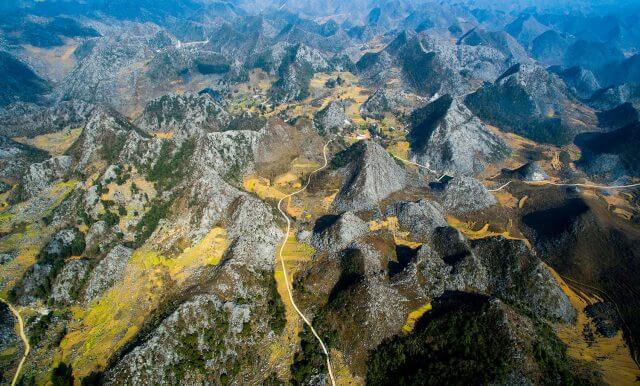
Doc Tham Ma
Legend has it that in the past, people let their horses pack their goods from the bottom of the slope. If the horse was strong enough to reach the top, the people would keep raising so the slope was named Tham Ma. This is the first pass that you need to conquer to step foot in Dong Van land. After crossing this slope, you will reach Fox Street.
Phố Cáo
Pho Cao commune is located right on NH4C, connecting Yen Minh with Dong Van. If you go to Fox Street on normal occasions, you won’t notice anything special here. However, if you go here in spring, the sight of cherry blossoms blooming brilliantly will surely hold many visitors.
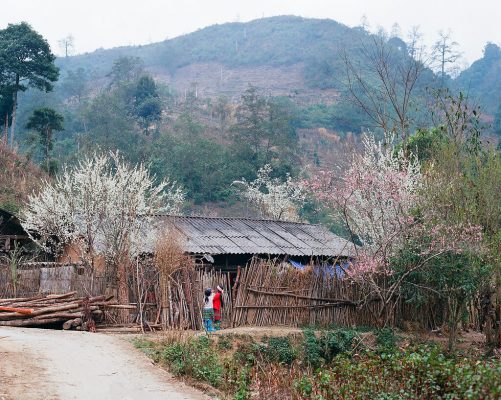
Phó Bảng
Pho Bang town is located deep inside a valley of the rocky plateau, where four sides are mountains. The road kept twirling from mountain range to mountain range, the sun kept jumping halfway up the sky and the valley was so deep that there was no one until suddenly Pho Bang appeared in a valley of roses. In the bare rocky plateau, the roses give off a gentle scent that makes you feel surprised.
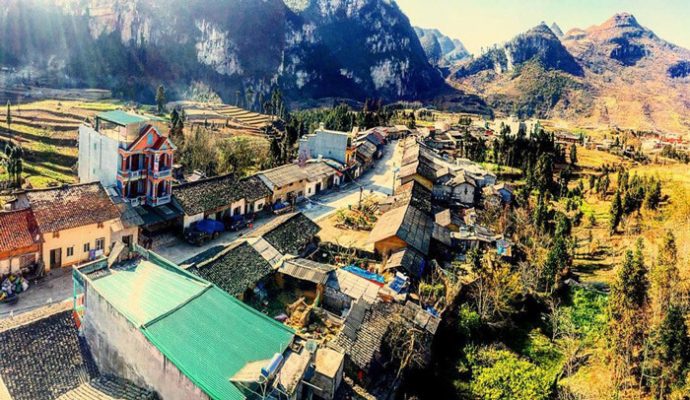
Behind the clouds of rose flowers, the small Pho Bang lies beside the cat-ear rocky mountains. The whole town has only a few dozen roofs, scattered on the main road and a few small branches. Along the main road, the houses are colored in the color of time. The people living here are mainly Mong and Chinese. The houses reported are over a hundred years old, old wooden doors with old Chinese words, moss-brown walls, yin-yang roofs. Simple life goes by each day.
Sủng Là
From Yen Minh to Dong Van town, to Pho Bang junction, where a beautiful pass embracing a green valley is the highest and most beautiful point for a panoramic view of Sung La. This place can be considered as the most beautiful upland commune of Dong Van rocky plateau. Looking down from the middle of the road, you will see Sung La as a peaceful and beautiful natural picture. Sung La is located among the rocky mountains of cat ears undulating, dark in color, solid houses with fading roofs of time.
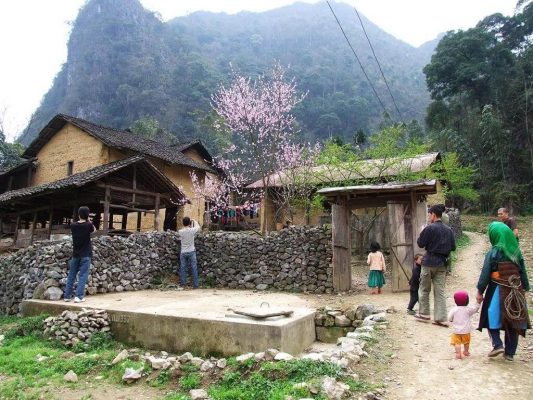
Sung La is also the place where triangular fields are planted in the cultural village of Lung Cam. This is one of the quite wide and beautiful triangular fields. Lung Cam village, Sung La commune, Dong Van district is home to many majestic and pristine landscapes and has more than 63 households of Mong and Han’s ethnic groups living for a long time.
Pao’s House
This is the home of Mr. Mua Sao Pao from the Mong people, where director Ngo Quang Hai has chosen to be the filming scene of “The story of Pao”, adapted from the work “The sound of lips behind the rock fence” by Do Bich Thuy. After being selected as the setting for the movie, the house has become a tourist attraction.
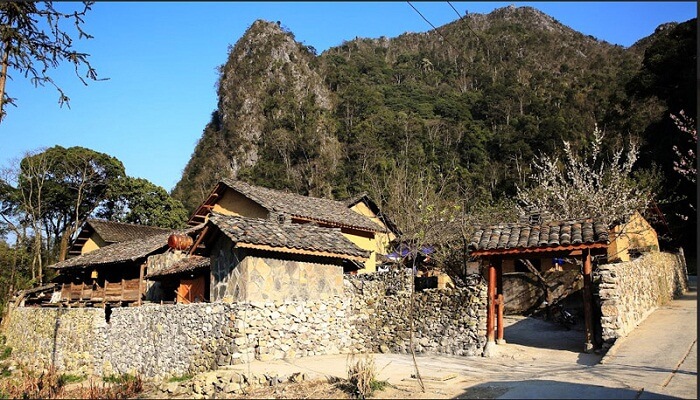
Tam Giác Mạch Lũng Táo
From NH4C, turn to the Lung Cu flagpole, you will go about a little way to the area of Lung Tao commune. Here there are triangular hills planted throughout a whole range of hills, the scenery is vast and much more beautiful when taking pictures. The triangular hill here is one of the first triangular photo spots of Ha Giang before.
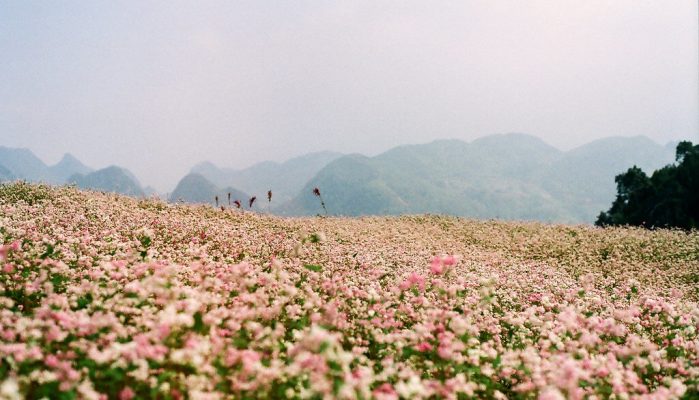
Dinh Vương
Before starting construction, King Meo Vuong Chinh Duc went to China to find a feng-shui master to Vietnam through the 4-district area under his jurisdiction to select the terrain. Finally, Vuong Chinh Duc and his teacher decided to stop at Xa Phin village, the terrain located in the middle of the Sa Phin valley. In particular, there is a block of soil floating high like a turtle’s hood, symbolizing the golden god. If you build a residence here, Vuong Chinh Duc’s career will become a success in the future. After the road lying beside the tall sandalwood trees, the superficial stone gate of the mansion of King Meo Vuong Chinh Duc in Sa Phin (Dong Van – Ha Giang) appeared on the top of the hill.
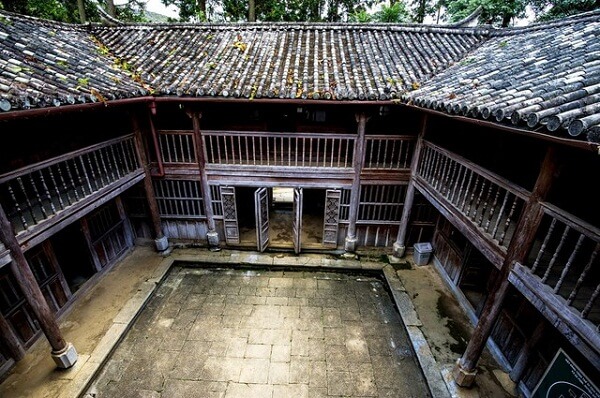
Vuong Chinh Duc was the head of the Vuong family of the Mong people in Ha Giang a century ago. Rich from cross-border opium growing, processing, and trading with China and Burma, he dominated the highlands and proclaimed himself king.
Behind the stone, the gate is the monumental pre-edifice of the mansion. The Vuong family residence was built in 8 years, costing about 150,000 white coins. Most of the builders are Muslim in the Yunnan region and the best of the Mong are.
Lung Cu Flagpole
The Lung Cu flagpole is located on the top of Lung Cu at an altitude of about 1,700m above sea level, in Lung Cu commune, Dong Van district, Ha Giang province. This is a small point on the Vietnam-China borderline. If we simulate relatively the shape of the Vietnam-China borderline into a cone, the two lowest points in latitude are A Pa Chai, Dien Bien and Sa Vi, Mong Cai, and Lung Cu is the apex of the apex. This cone is also the highest point in the North Pole of Vietnam.
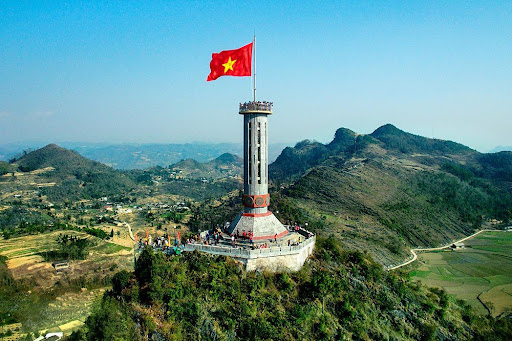
The Lung Cu flagpole is not actually the North Pole of Vietnam, this real pole is located under the Nho Que River, where it takes a whole day and a journey with the guidance of people who know you to come. Currently, about 3km from the Lung Cu flagpole, another iconic North Pole was built in Xeo Lung village.
Milestone 428
Landmark 428 is not the northernmost point, but it is the most northern landmark of the country. This is the Vietnam-China border landmark closest to the northernmost point. The landmark is about 500m from the Nho Que river along the way the birds fly. Nho Que River is a common river of Vietnam and China, so it is at the same time the boundary of the two countries.
North Pole Landmark
At Xeo Lung village (about 3km from Lung Cu flagpole), a symbolic northernmost point is built. Up to the present time, this is the closest accessible point to the north pole of the country. Standing on the observatory (simulating One Pillar Pagoda) covering the boundary strip of the North Pole cone, where the Nho Que River begins to flow into Vietnam.
Dong Van Ancient Town
Dong Van Old Town is located in Dong Van town, Dong Van, Ha Giang. The center area of old Dong Van town belongs to Dong Quan, Nguyen Binh Chau, Tuong Van, Tuyen Quang province and has a history of development in architecture and culture for hundreds of years. In the 1880s, when occupying this area, the French made plans and left important planning and architectural points, especially Dong Van (old) market, built of stone in the 1920s almost intact to this day.
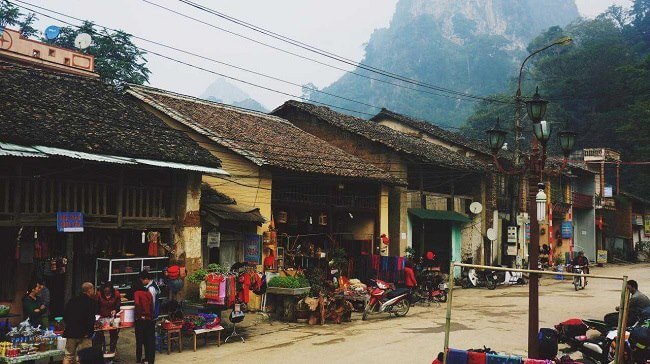
Dong Van Market
Dong Van Market is an old market, located in the population of Dong Van old town, this is the largest center of economic exchange, commodity exchange, and culture in the Dong Van plateau. Each week the market has a single session on Sunday. On the day of the fair, the small, quiet old town became noisy and crowded like a festival with colorful costumes of the Dao, Mong, Tay, Nung, Giay, Lo Lo,… pouring from the Reclining mountains to the market. They bring vegetable baskets, firewood, pigs, dogs,… Some people have to go from 3 am, cross the mountains to get down in time for the market.
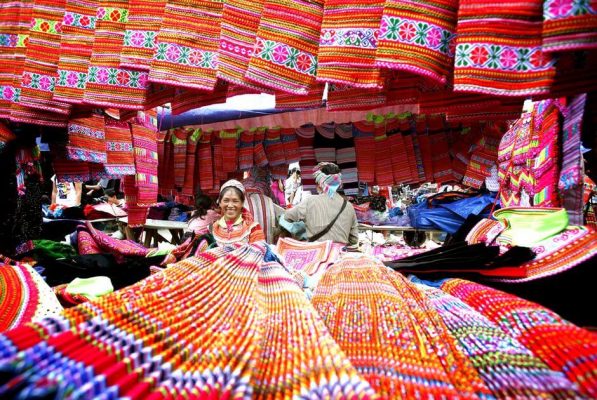
The uniqueness of the Dong Van market is the items that people bring to the market, mainly agricultural products and local products made by them. Unlike the low-down market where people come to the market to buy and sell, the people come to the Dong Van market. In addition to buying, selling, and exchanging goods, a market is also a place for people to exchange and meet.
Meo Vac
Ma Pi Leng Pass
Mã Pi Lèng is a name in Quan Hoa language which means “living off the horse’s nose” literally. But in a figurative sense this name refers to the greatest danger of the mountain, where the mare climbed to the top of conception and died, where the slope was so steep that the passing horse had to stop breathing, or the top of the mountain stood up like However, according to some indigenous H’mong people, the correct name of the pass is Mao Pi Leng, which means “cat’s nose bridge”.
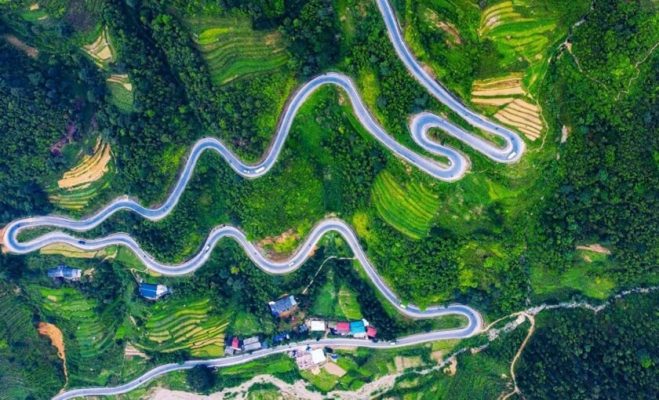
The top of Ma Pi Leng in the three communes of Lai Lung, Pa Vi, and Xin Cai (Meo Vac, Ha Giang) in the Dong Van rocky plateau is about 2,000 meters above sea level, made up of a series of sediments including limestone, luminous shale, silicate limestone containing fossils some 426 million years ago, including many of the slides and fissures caused by mountain-forming activities. The landscape of this area is jagged with rocks, in which the deep valley of the Nho Que River is cut in half, one side is the top of Ma Pi Leng and the other is Sam Pun (Sam Pun), where border landmarks and the border gate from Xin Cai went to Dien Bong, China. French scholars, from a hundred years ago, called Ma Pi Leng peak in particular and Dong Van Plateau Global Geopark in general as a “Geological Monument”. Going on the Ma Pi Leng Pass, looking down into the abyss, Nho Que river is just as small as a thread. It takes many hours to reach the water surface of the river.
Vách Đá Thần
This is a trail for those who love trekking activities, about 5 km from the youth volunteer monument area. This walkway is right above the legendary Ma Pi Leng pass, so it is also known as Ma Pi Leng B. Although handrails are running along the road, there are still relatively difficult sections to go to, you should be careful. be careful when moving.
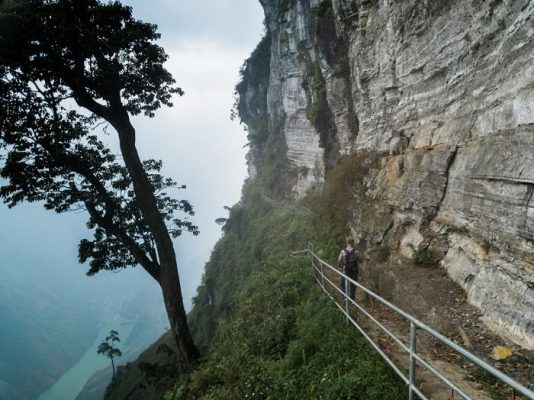
Tu San Alley
Tu San Canyon is the deepest pool in Vietnam and Southeast Asia, with a cliff height of up to 700 – 900 m, a length of up to 1.7 km, is the most spectacular scenic spot of the Dong Van rocky plateau. To get down Tu San Alley, you can take a motorbike along the route in Ta Lang village, Lai Lung. From here down to the boat station below about 8km with extremely steep pass sections, but the landscape is extremely beautiful.
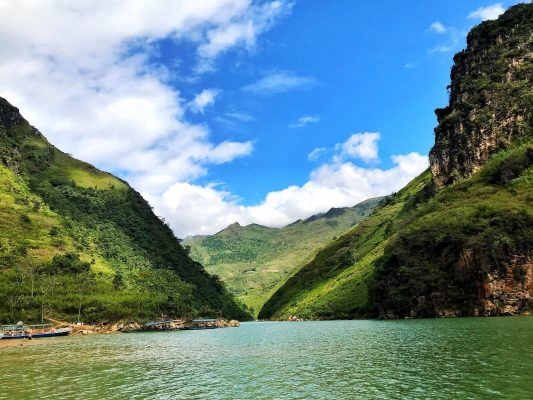
Mã Pì Lèng Viewpoint
If you do not have the opportunity to go down to Nho Que stream to see Tu San alley from below, you can stop here for pictures taken from above. In the past, this place was just a cliff with difficult access, often only young people climbed out to take pictures. Later, when the number of tourists increased, this place was built into a place to sell local specialties along with making stairs leading down to make it more convenient for tourists.
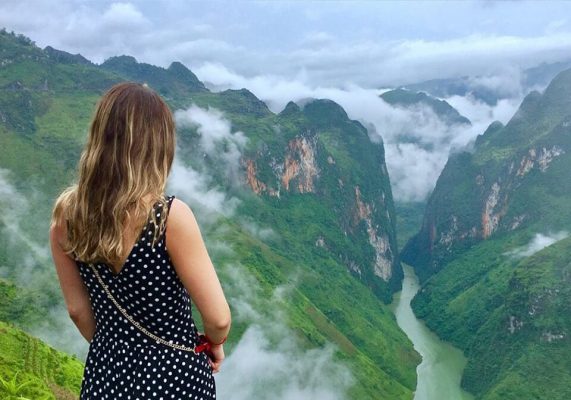
Ma Pi Leng Panorama
Originally a cafe, motel with direct views down the Nho Que river. However, after years of noise, this place is now only a place to admire (with a fee), no more business is allowed to sleep.
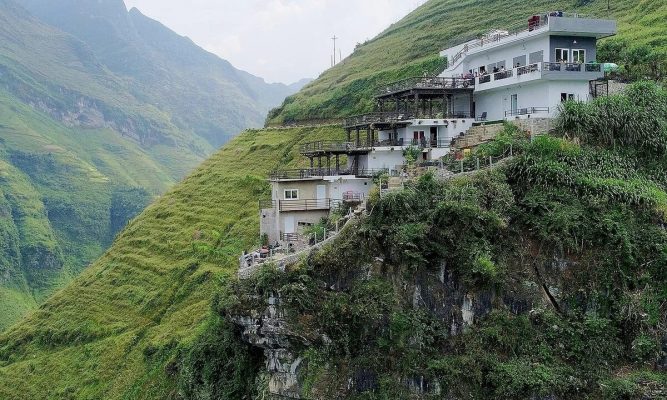
Meo Vac Night Market
Meo Vac Night Market is located in the district’s central market, with an area of more than 3,500 m2, arranged with main areas, including souvenir shop area and typical products; beverage and barbecue area; food court; cultural – cultural organization area. Every Saturday night, there will be 3-4 groups performing folk tunes, love-matching singing, dancing, and performances of typical ethnic musical instruments to serve the public.
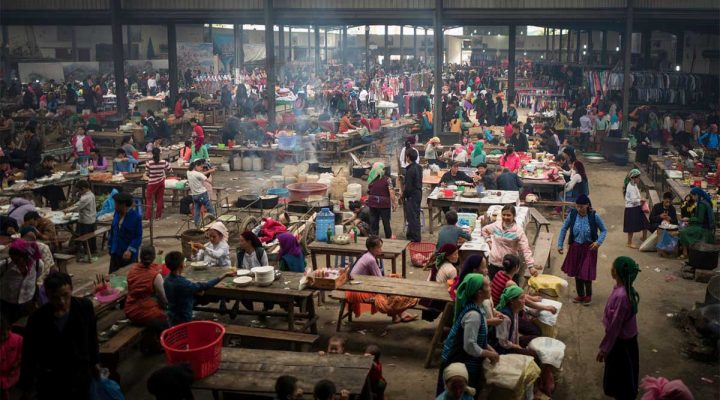
Khau Vai Love Market
The annual Khau Vai Love Fair takes place in Khau Vai Village, Khau Vai Commune from March 25 to 27 of the lunar calendar. Khau Vai love market, also known as Phong Luu love market, is famous for its uniqueness on the rocky plateau on the northernmost tip. This is a very romantic place for couples who love each other. But they cannot come together, they come here to find the old figure that their hearts have once loved. It is on the March day of the lunar calendar every year, they find each other together to confide and share many sad and happy things in life with indescribable choked emotions.
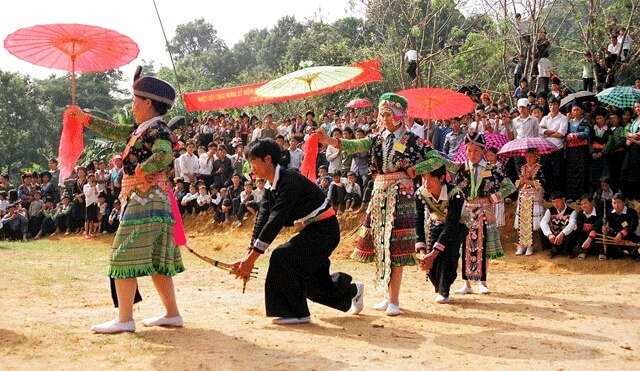
Xín Cái
This is the first of the three most remote communes of the Meo Vac district. The road from Meo Vac to Xin Cai also runs along the Nho Que River, to Trang Huong Bridge, which is a relatively low point where you can walk down the riverbed during dry times.
Thuong Phung
Passing Xin Cai, you will reach Thuong Phung, where there are a pair of auxiliary border gates named Sam Pun – Dien Bong. If you come here on Goat day and Ox day every month, you can also visit the Sam Pun beef market in Mo Phang Pine. The market is a place to exchange and buy and sell different kinds of cattle of people in the border areas of the two countries.
Son Vi
This is the last commune of Meo Vac, a remote border commune, located at an altitude of more than 1000m and about 50km from the district center. Because the road is not convenient, not many people know about Son Vi, is it just those who love to learn about the border markers here.
Delicious dishes and specialties in Ha Giang
Ha Giang is not only known as a mountainous province with many majestic landscapes, customs, rich festivals, and extremely high rocky mountains, but here we also see it as a land with many natural products that are very attractive and one of the attractions that tourists are culinary culture is the dishes made from many available ingredients in nature, becoming strange and interesting dishes. Special taste and impression is only available in the highland highlands of Ha Giang
What to eat when traveling to Ha Giang
Egg rolls
In the cold rocky region of Ha Giang, one has to eat something very hot and spicy to withstand the gloomy atmosphere emanating from the mountain rocks. But the egg rolls, the specialty of this country, is “cold food”, served with a cup of hot and sweet broth. Ha Giang’s delicious egg roll cake is because the combination of the cake flour is flexible enough, the meat is rich, and the bowl of sauce has a distinct taste.
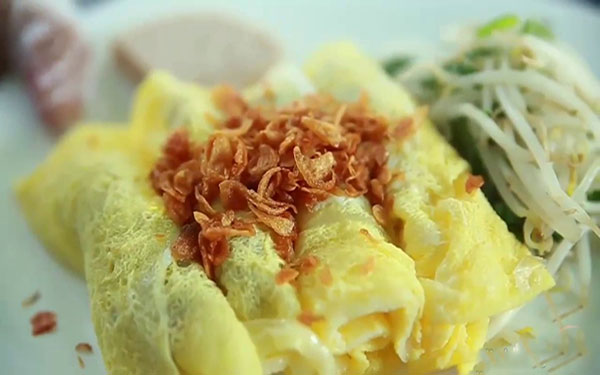
This is a dish “just eating while waiting”, when the seller orders, the seller coats the cake, smashes the eggs on the surface of the dough, and then wraps them in the crust. Eggs are not fully ripe, but peaches are ripe, they have a greasy taste, quickly dab into a bowl of simmered sauce from the bone, different from the usual fish sauce. Diners can also choose to add a piece of white sausage to serve. Egg rolls are mainly sold in the morning in Ha Giang city, Dong Van old town, and some markets.
Black Chicken Hotpot
It is just a hotspot as usual but the main ingredient is black chicken, a famous kind of Mong chicken, served with highland specialty vegetables such as kohlrabi, beef Khai,… in the chilly weather of the highlands. original Dong Van stone.
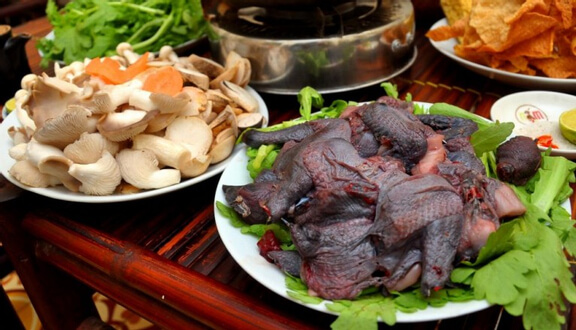
Five colored sticky rice
The community of ethnic groups in the northern mountainous region possesses a very diverse and unique culinary culture. In which, the five-color sticky rice converges traditional values, which have the meaning of cosmic conception, yin-yang philosophy, and noble human meaning. It is called five-color sticky rice because it is different from ordinary sticky rice. Five-color sticky rice is created by five kinds of sticky rice with five different colors. It is red, yellow, blue, purple and white. You can easily find five-colored sticky rice at markets in Ha Giang.
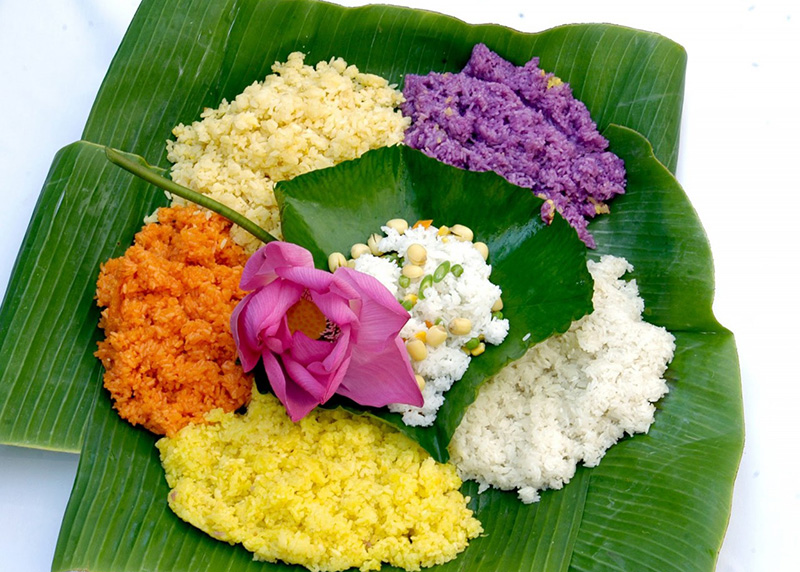
The cooking method of the five-color sticky rice of the regions is the same. However, depending on the conditions of each region, they can mix or use different colors in addition to the above basic colors to create five-colored sticky rice. Five-color sticky rice ingredients include: sticky fragrant glutinous rice, the seeds are not mixed with the forest leaves to color them. In red, use Gac fruit, red rice leaves. In green, use ginger leaves, green sticky rice leaves, or grapefruit peel, bitter bamboo shoots, and burn ashes soaked in water mixed with lime. In yellow, use the old turmeric to crush the water. In purple, use black rice leaves, or the following leaves,… Before dyeing sticky rice, clean glutinous rice is soaked in cold water for 6-8 hours so that the rice grain has a moderate bloom. Divide the rice into 5 parts, each corresponding to a color. After dyeing, the last stage is sticky rice. This stitch requires a lot of skill to get the desired sticky rice dish. Rice with the most fading color is added first, followed by the remaining colors, white on top. Must have a separate color for each color. There are places displayed as 5 petals flower, each petal a color, some places are displayed in the shape of terraced fields, each step is one color, some places use wooden molds to build towers, many floors,…
Thang Co Dong Van
The aroma of cardamom, guava seeds, and lemongrass roots, mingled with the fatty taste of meat, warms up the chilly atmosphere. Hmong men who go to Dong Van market all want to eat a bowl of triumph and drink some wine with their friends. It is thought that whoever has many friends, he or she will be invited to a lot of wine. Those who get drunk when they go back to the market are kind people because they have many friends.
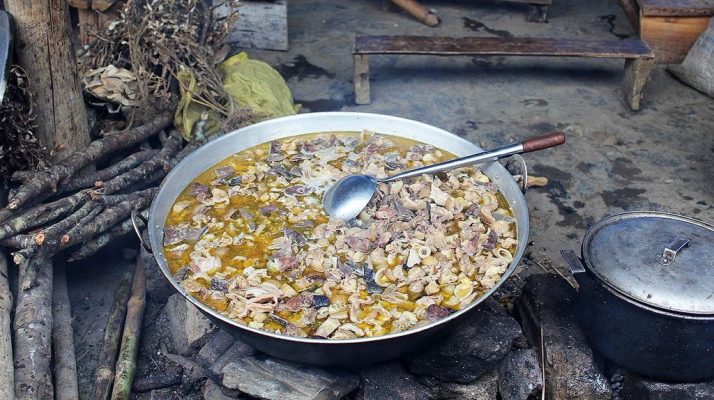
Dong Van district market has now been moved to a guest position, broader, solidified, looks like the market down the river, but the houses and roofs cannot replace the umbrellas of ethnic people. In the middle of the market, the winning stalls were placed behind the groceries. Hmong people often bring their mummies, go to the market to buy more wine bowls, and win the game so they can invite friends to have fun together. Eat, try to squat, put food on a long wooden board and eat with a wooden spoon. Besides, there is always a bowl of salt with a spicy chili. A spoonful of hot pot with a little chili salt will be very rich. Trying to win is necessary to have friends to ask about family stories, wish each other good health and laugh at the market. Drinking alcohol to the point where ivory will sing and blow the khene.
“Ấu Tẩu” Porridge
In Ha Giang, many unique dishes will never be forgotten by visitors there. “Ấu Tẩu” porridge is such a cuisine.
A cold winter night, wandering around Ha Giang city, looking for a corner of the shop and ordering a dish of porridge. All kinds of flavors in a small bowl of porridge: the pleasing aroma of yellow flower sticky rice mixed with fragrant rice grown on a fine-grained upland field, the pulp of the larvae is carefully simmered and the broth is greasy and fragrant. fragrant leaves, seasoning leaves. The porridge bowl looks very attractive because of the harmonious combination between rice, minced meat, bone broth, herbs,… It is not easy to cook a real bowl of porridge. After soaking in the water, the tubers are soaked in condensed rice for one night and then simmered for 4 hours. The yellow flower sticky rice is mixed with fragrant non-glutinous rice cooked in pure rice broth and eggplant powder. Add a little minced lean meat, a little extra seasoning. Porridge when eaten has a bitter taste, so many people call it bitter porridge.
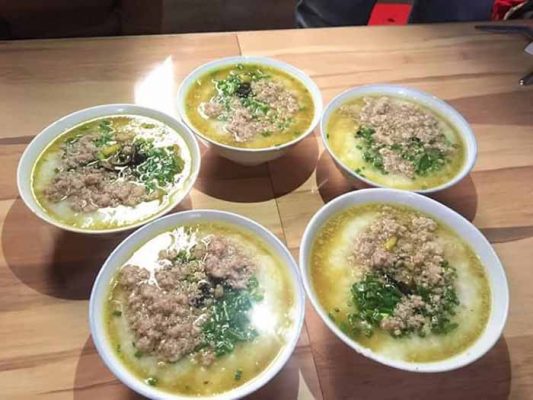
Many people come to Ha Giang, if they have enjoyed it once, they will come to eat again. Juvenile porridge is not only a simple dish but also a tonic for relief. Bitter porridge in Ha Giang is available every season, but only sold at night. In the cold winter in the mountains, you can sit in the warm pink kitchen and enjoy rice porridge. Ha Giang bitter porridge is also enjoyable in the dining style for those who love discovering new things.
Men Men of Ha Giang
After the harvest, the corn is classified, dried with the shells, put in the attic, lined up, to be used gradually. Corn was supposed to be, the fan was clean and then drunk with a stone mill. Milling the corn requires meticulousness and time. When grinding, there must be two people, one pulls the rosary, the other stands to remove the seeds. Ground corn ensures that it is smaller than the broken grain for easy storage. When you put the cornstarch in the pot, sprinkle a little water, cover it, place it on a pan of water and wait for the aroma to emit cooked rice. More carefully, people do things twice. The first turn is not completely ripe. Pour into a trick, beat, wait to cool down, then sprinkle a little water, put it back into the second turn. Steamed corn flour rice is known as Mem Mem.
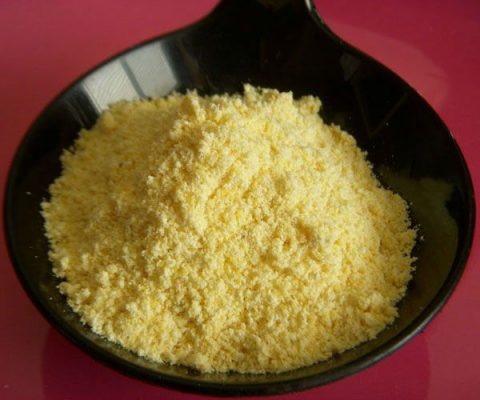
Bánh Tam Giác Mạch
At the end of the triangular flower season, local people will harvest the seeds and sell them to cooperatives at quite high prices. This helps people to have more income. This seed is very small, about half the size of a black bean. Because it is grown in nature, the triangle circuit here is not affected by toxic chemicals.
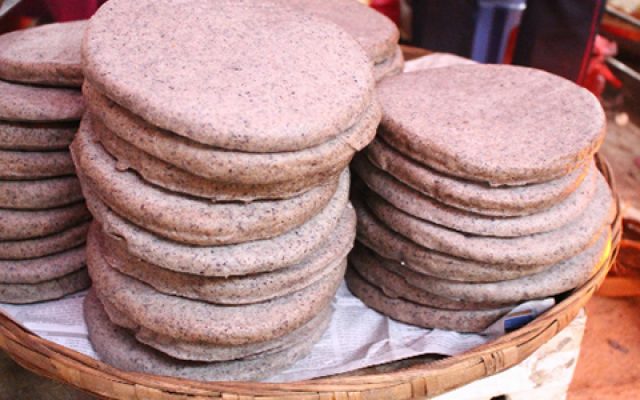
To make such a delicious cake, people have to go through many stages. First, the triangular seeds must be dried enough and then ground by hand. The grinding process also needs dexterity to make a very fine dough, avoiding pigmentation after processing. People knead the ground dough with water and then mold it into a mold and bring it to bake. The price of the product after the hot oven is 10,000-15,000 VND per cake. Although not as expensive as many other items in other places, but triangular cakes are contributing largely to the culinary, tourism, and economic development of the rocky highlands.
Bánh Hạt Dền
The butt people call amaranth seeds “Sú Tù”, which means “rice heaven”. The seeds of the amaranth are round, small as a sesame seed, and are clear white. Each family can earn more or less depending on the area of maize cultivation, the house has tens of pounds or less, and the house has a lot of weight. People keep a little to do the same for the next season, and the rest will be used for baking. Prawn is roasted, peeled, white, and fragrant, then ground into powder, then mixed with mint honey, molasses or sugar to make a blue tea cake or roasted with sugar, honey, and rolled into a cake burn.
Thắng Dền
Going to Dong Van, in the middle of town, absorbing winter wind, and sitting by the fire to eat a bowl of amaranth, nothing is as warm and interesting. Thang amaranth looks like a boat drifting in Hanoi, like a floating sewer cake in Lang Son, made from glutinous rice flour, which can be made vegetarian or wrapped with bean paste. Each dough is molded a little bigger than the tip of the thumb, put into a pot of boiled broth, until it emerges, the shopkeeper will use the ladle to pick it up. Whether or not the amaranth is delicious or not is in a bowl of broth, made with a sweet mixture of sugar, creamy coconut milk, and the spiciness of heated ginger. You can sprinkle it with sesame or peanuts for more dishes. Diners often put one or two amaranth balls into their mouth for a while, soaked in the sweet and fatty taste of sugar water, the spiciness of fresh ginger, and the muddy taste of sesame seeds.
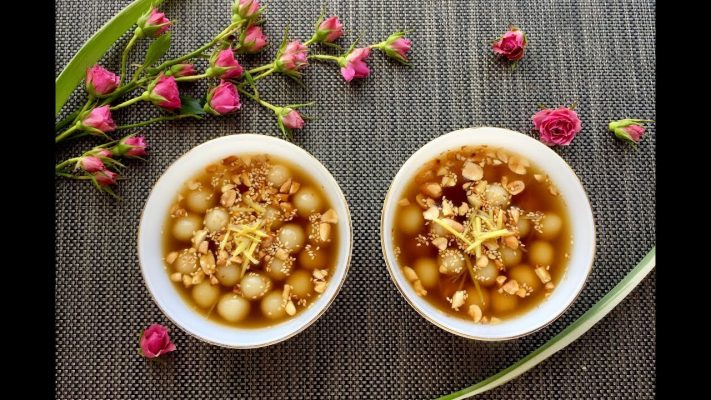
Bánh Chưng Gù
Legend has it that the image of a woman wearing a hump on her back to pick rice and pick corn on the field is the inspiration to create the shape of Ha Giang’s Banh Chung. The Tay ethnic Banh Chung has become a delicious dish that spreads far away because of the unique ingredients and processing methods that create a different taste.

Rêu Nướng
For a long time, stone moss is only considered a type of aquatic that does not have much effect. But for the Tay people in Quang Binh commune, moss is considered a specialty in their cuisine. The dishes made from rock moss are also known as mussels. This dish is both delicious, nutritious, and has a very unique flavor. According to local people, when looking for moss, they often choose large mossy beaches, because there is both a lot of moss and delicious. Fresh moss is brought back and crushed thoroughly to clean all the mucus, then can be processed into many dishes.
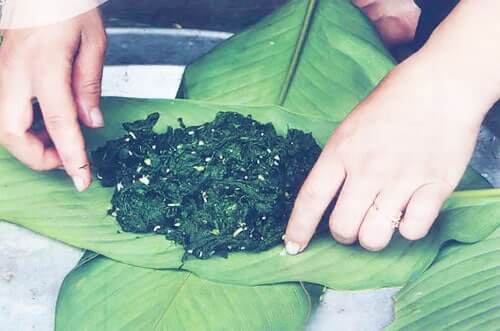
Stream moss is many, but good moss is few. Moreover, moss can be eaten according to the season, so for people here, moss is also a precious food,… Moss can be processed into many dishes such as moss, dry moss, but the most unique is still mixed dishes. with spices and then baked.
The Tày people often have a saying: “Quẹ chí áp, táp chí hơ”, which means that the crabs must be baked against charcoal, and its fresh and fragrant water has not yet fallen, then the crab is cooked, when grilled, it does not have to be rotated many times cook on one side, then grill on the other side. When using two fingers to see soft, the crab is ripe. Because moss is edible according to the season, in addition to processing fresh moss, they also dry the moss and store it upstairs to make a reserve dish. Only you can treat the dry moss in the kitchen upstairs.
Cơm Lam Bắc Mê
Ha Giang is a fertile area with famous and delicious sticky rice, Bac Me lam rice is gradually becoming a typical specialty of the Tay ethnic group here.
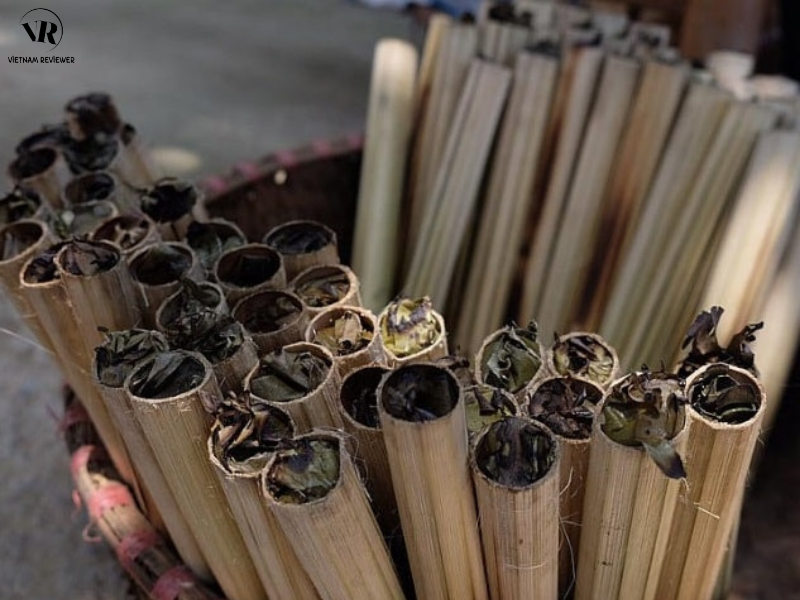
Lam rice processing technique is very simple. The raw materials are sticky rice, which is soaked thoroughly, and the cooking water is usually the innermost underground water, put in a bamboo tube and covered with banana leaves. . The young plants, the trunk, the family of bamboo are used. Each bamboo tube is cut off one end of the tube, the other end acts as the bottom of the pot. Sticky glutinous rice, sprinkle with salt, mix well, put the rice in a bamboo tube, and pour the amount of water over the rice surface. The mouth of the tube is plugged with fresh dong or dried banana leaves and baked on the bamboo tube with rice that is held over a fire or on a pile of embers, slowly spinning while allowing heat to apply evenly around the tube shell. About an hour or so later (depending on whether the rice tube is big or small), the smell of sticky rice is aromatic, which is a sign that the rice is cooked.
Ha Giang’s specialties bought as gifts
Ha Giang Corn Wine
In each market, in addition to the agricultural products for life, an indispensable “specialty” that is regularly traded and used on the spot is corn wine.
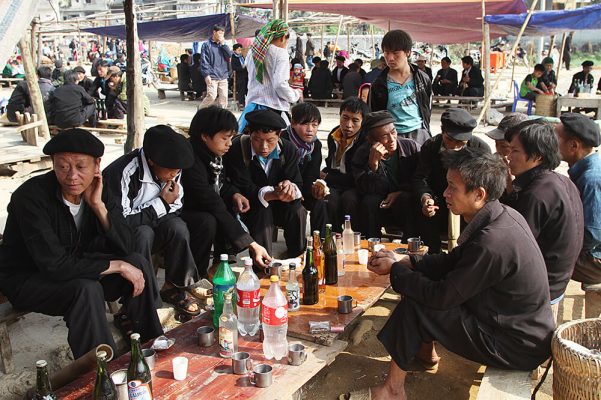
The wine is cooked from the native corn of the Plateau along with the traditional leaf yeast, so when consumed, it has a sweet, fragrant taste of corn and does not cause headaches. Corn wine is present in all Ha Giang markets that you go through, this is also an indispensable drink when enjoying Thang Co.
Mint Honey of Meo Vac
For a long time, peppermint honey products have been known to consumers for their good quality, bees raised in the natural environment, and honey from wild peppermint flowers is only available on Dong Van Plateau.
Mint honey is produced by the people here in traditional methods, mainly from mint flowers and some flowers of wild herbs. Mint honey is light green, mixed with a hint of yellow, and when enjoyed, it has its 5 unique aromas, sweet and sweet taste.
Ba Kích Rừng Quản Bạ
Ba Kích used to soak or make medicine are a vine of the coffee family and have the scientific name Morinda Officinalis stow. Ba Kích grows quite a lot in the secondary forests in the midlands and mountainous areas of the North, under the canopy of tropical moist broadleaf forests. The localities with many types of these trees in our country can be mentioned as Ha Giang, Lang Son, Phu Tho, Quang Ninh, Hoa Binh,…
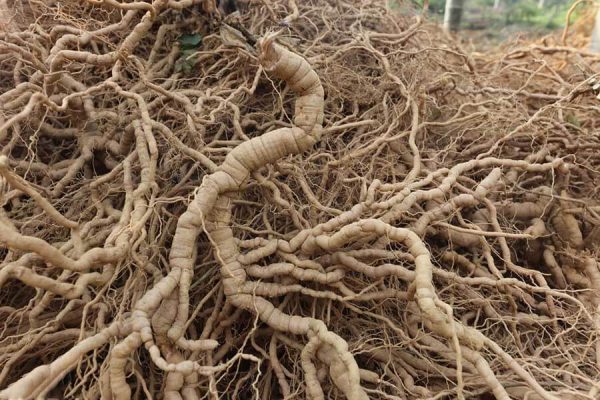
Hồng Không Hạt Quản Bạ
Quan Ba seedless persimmon trees have existed for a very long time. At present, there are still persimmon trees over 300 years old in the Nghia Thuan commune. The famous deliciousness of this fruit is made up of natural elements of the geographical area of Quan Ba. Specifically, Quan Ba has an average altitude of over 1,000 m above sea level, the terrain is quite flat, in some places with a slope below 20 degrees, thick soil layer, and less erosion. The climate here is cool all year round so seedless persimmons give good quality, high yield, and stability.
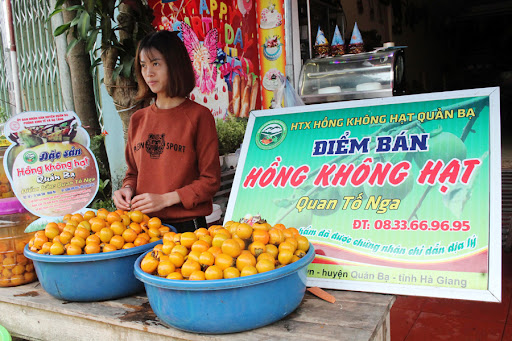
Unlike seedless persimmons in other localities, Quan Ba seedless persimmons are indigenous varieties, which have been cultivated by ethnic minorities (Mong, Dao, Tay, Bo Y,…) for a long time, at the same time. is preserved and developed. Quan Ba seedless persimmon has some specific properties compared to other products of the same type such as Crispy fruit meat, sweet, fragrant, fine powder; The large fruit, the hard shell, and the firm flesh are easy to store and transport.
Orange Bac Quang
For a long time, oranges have become a famous specialty whenever people come back and forth about Bac Quang, the next thing is tea. That is because this land has climatic and soil conditions unlike any other to create oranges with a distinct flavor, extremely sweet and attractive in the South of Ha Giang province. In addition to its dark yellow color, small stalks, Bac Quang crockery orange also has a very specific aroma, solid fruit, very fragrant and sweet when eaten.
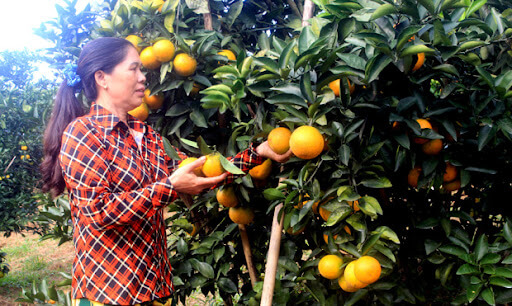
Trà Shan Tuyết Fìn Hò
Snow Shan tea trees in Phin Ho live thousands of meters high in the mountains of Sin Ho with a cool year-round climate. Fin Ho Tea is processed from tea buds of 1 shrimp and 2 young leaves picked from ancient snowy Shan tea trees over 200 years old in the high mountains of Lin Ho village – Thong Nguyen commune, Hoang Su Phi. The farming and processing process does not use chemicals. The flavor of the tea here is especially pure and delicious, bestowed by nature by the soil climate at an altitude of over 1300m.
Some notes when traveling to Ha Giang
- If you ride a motorbike, you should not follow suitcases, especially those who fly out from the South. Please use the backpack to store personal belongings, the suitcase is relatively cumbersome when tied in the back of the motorcycle to change the center of the car, not very convenient for moving.
- If you ride a motorbike from Hanoi, you should only stop at Ha Giang city to ensure safety. When going to Ha Giang City around 4-5 pm, at this time if you move to Quan Ba, there is a high chance of having foggy weather right at Quyet Tien.
- You should only drive yourself around in Ha Giang if you ride a motorbike quite firmly, it is best to have experience riding a mountain bike because in Ha Giang there are many bends on your sleeve, which is very dangerous when going downhill. You should refer to the article about riding a motorbike for the first time.
- If you rent a motorbike in Ha Giang, always remember to check the car before picking it up. Vehicles must have at least 1 left mirror (2 mirrors are recommended for good rear visibility).
- Please use a helmet sealed at least 3/4 heads to ensure safety, absolutely do not use low-quality helmets. Remember, your life comes first. If renting a car in Ha Giang, most stores are now equipped for customers to use
- If you come from Ha Giang city, fill with gas in Ha Giang, Yen Minh, Dong Van, and a little more in Quan Ba during the day, you will not have too much gas when you return the car.
- On foggy and drizzly days, you do not go on the road too late (around 5-6 pm), it is best to try to reach the end of the journey while it is still bright. Ha Giang has several roads that, when blind, are extremely limited, very dangerous to move.
- During the peak season, always book a hotel/hostel/homestay reservation as well as a bus ticket 5-7 days before departure to ensure a reservation. Near the departure date please call to confirm.
Ha Giang Tourism Schedule
Normally, for those who go to Ha Giang for the first time, you should arrange a travel time of about 3 days or 4 nights, this time is considered just enough for you to discover interesting things in this land. Along with Pheo suggest some reference schedules when traveling to Ha Giang so that you can easily visualize and schedule your schedule.
Tour 1: Hanoi – Ha Giang 2 days 3 nights
This schedule is suitable for those who are limited in time, but following this schedule, the destinations in Ha Giang will not be very much.
- On Friday night, take a bed car to go to Ha Giang city, this 2-day 3-night schedule, the cost of renting a motorbike in Ha Giang will be cheaper than if you take the car yourself.
- On Saturday morning, around 4-5 am, you will be present in Ha Giang city, receive your motorbike, have breakfast, refuel and start your journey.
- Ha Giang City – Doc Bac Sum – Quyet Tien Market – Quan Ba SkyGate – Tam Son Town – Yen Minh Pine Forest – Yen Minh District (About 100km) – Sung La – Meo King Palace – Lung Cu Flagpole – Thi Dong Van town (90km). Sleep in Dong Van at night, enjoy coffee in the old town
Sunday morning, get up early to have breakfast, visit Dong Van market, and walk around Dong Van’s old town. About 10:00 am leaving Dong Van to Meo Vac to visit Ma Pi Leng Pass, the top of the pass is honored by backpackers as one of the “four great passes” of the North. Have lunch at Meo Vac and then go straight to Ha Giang city.
– Monday morning was in Hanoi
Tour 2: Ha Giang – Dong Van – Du Gia
General information: This is a popular itinerary for you to explore Ha Giang for the first time, not too long but enough for you to learn about the culture of the people of this country.
Day 1: Hanoi – Ha Giang
Thursday night, take a bus to bed in Ha Giang city, rent a car in Ha Giang city or send a motorbike from Hanoi if you cannot rent a car.
Day 2: Ha Giang – Quan Ba - Yen Minh – Pho Bang – Sung La – Dong Van
- At 7h00: Have to breakfast + Refuel
- At 7:30 – 9:30: Ha Giang – Quan Ba (46km) – Visit the Sky Gate and Quan Ba Twin Mountain if your 2nd day coincides with Saturday morning you will have the opportunity to visit Quyet Tien Market
- At 11h00 – 12h00: Quan Ba - Yen Minh (50km) on the way to Yen Minh you will see Yen Minh pine forest right next to the national highway. Lunch break in Yen Minh
- At 13h30 – 15h00: Yen Minh – Pho Bang (40km), starting here, you will see the wonderful and majestic beauty of Dong Van’s rocky plateau. Visit Pho Bang town to oversleep.
- At 15h00 – 16h30: Leave Pho Bang and back to Dong Van intersection, you will come to Sung La, which is famous for being the filming location for the movie Pao’s Story
- At 16h30 – 17h30: Sung La – Dong Van. Overnight in Dong Van and visit cafe Old Quarter
Day 3: Dong Van – Lung Cu – Dinh Vuong – Dong Van – Ma Pi Leng – Meo Vac
- At 7h00 – 9h00: Have to breakfast. Walking around Dong Van market if on the right day of the market, visit Dong Van old town, a neighborhood with ancient beauty hundreds of years old
- At 9h00 – 11h30: Dong Van – Lung Cu (26km) – Dinh Vuong (26km) – Dong Van (15km) up to the northernmost point of Vietnam, then leave Lung Cu to return to King Meo Vuong Chi Sinh Palace. Afternoon break and have lunch at Dong Van
- At 13h30 – 15h30: Dong Van – Ma Pi Leng – Meo Vac – watching Nho Que River from the top of Ma Pi Leng Pass, one of the Four Great Pass peaks of Northern travelers
- At 15h30 – 17h00: Go back to Meo Vac to visit some places. See tourist destinations in Meo Vac. Overnight at Meo Vac
Day 4: Meo Vac – Mau Due – Du Gia (depending on weather) – Yen Minh – Ha Giang
- At 7h00: Have breakfast
- At 7:30 – 12:30: Meo Vac – Yen Minh – Quan Ba. Walking around at some tourist attractions in Quan Ba and then back to Quan Ba for lunch
- At 13h30 – 16h00: Quan Ba - Ha Giang. Resting in Ha Giang city, waiting for 8 am on the bus. Early in the morning, Thursday was present in Hanoi
Tour 3: Hanoi – Ha Giang – Ba Be
With this schedule, you can run in a closed loop with two different paths back and forth. However, you need to use a private vehicle (car or motorbike)
Day 1: Hanoi – Ha Giang
On this day, you will move from Hanoi to Ha Giang, the time is about 8 hours.
Day 2: Ha Giang – Quan Ba - Yen Minh – Pho Bang – Sung La – Dong Van
- At 7h00: Have to breakfast + Refuel
- At 7:30 – 9:30: Ha Giang – Quan Ba (46km) – Visit the Sky Gate and Quan Ba Twin Mountain if your 2nd day coincides with Saturday morning you will have the opportunity to visit Quyet Tien Market
- At 11h00 – 12h00: Quan Ba - Yen Minh (50km) on the way to Yen Minh you will see Yen Minh pine forest right next to the national highway. Lunch break in Yen Minh
- At 13h30 – 15h00: Yen Minh – Pho Bang (40km), starting here, you will see the wonderful and majestic beauty of Dong Van’s rocky plateau. Visit Pho Bang town to oversleep.
- At 15h00 – 16h30: Leave Pho Bang and back to Dong Van intersection, you will come to Sung La, which is famous for being the filming location for the movie Pao’s Story
- At 16h30 – 17h30: Sung La – Dong Van. Overnight in Dong Van and visit cafe Old Quarter
Day 3: Dong Van – Lung Cu – Dinh Vuong – Dong Van – Ma Pi Leng – Meo Vac
- At 7h00 – 9h00: Have breakfast. Walking around Dong Van market on the right day visit Dong Van old town, a neighborhood with ancient beauty hundreds of years old.
- At 9h00 – 11h30: Dong Van – Lung Cu (26km) – Dinh Vuong (26km) – Dong Van (15km) up to the northernmost point of Vietnam, then leave Lung Cu to return to King Meo Vuong Chi Sinh Palace. Afternoon break and have lunch at Dong Van.
- At 13h30 – 15h30: Dong Van – Ma Pi Leng – Meo Vac – watching Nho Que River from the top of Ma Pi Leng Pass, one of the Four Great Peaks of the Northern people, or down the boat station under Nho Que River to see Tu alley Estate.
- At 15h30 – 17h00: Go back to Meo Vac to visit some places. Overnight at Meo Vac.
Day 4: Meo Vac – Niem Son – Bao Lac – Pia Oac – Tinh Tuc – Ba Be (200km)
- At 7h00: Have to breakfast, fill up with gas, and tie things
- At 7h30 – 11h00: Run from Meo Vac along Niem Son road to Bao Lac, go towards Tinh Tuc, reach the intersection about 5km away from Tinh Tuc, turn right to the road to some communes of Phan Thanh, Ca Thanh of Nguyen Binh district (Cao Bang ) Lunch break on the road. Along this road, you will pass ghost villas (villas built in the French era).
- At 13h00 – 17h00: Run back to Ba Be to rest for dinner, you can take a walk around the area of Ba Be National Park in the evening.
Day 5: Ba Be – Phu Thong – Bac Kan – Hanoi (220km)
- At 7h00: Get up for breakfast and visit the area of Ba Be National Park, rent a boat to see three tanks (depending on the actual time).
- At 11h00: Depart for Hanoi, in the evening, arrive in Hanoi.
Related Article: Traveling experience in Ban Gioc Waterfall that tourist should know
Let start your trip to Ha Giang with us! If you have any feedback or need help, please send an email through vietnamreviewer.contact@gmail.com!
Noted: All information and pictures are collected!

